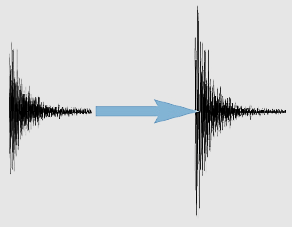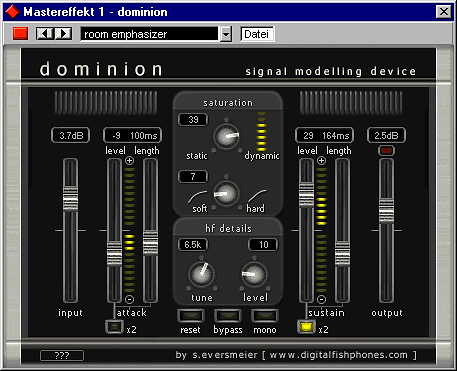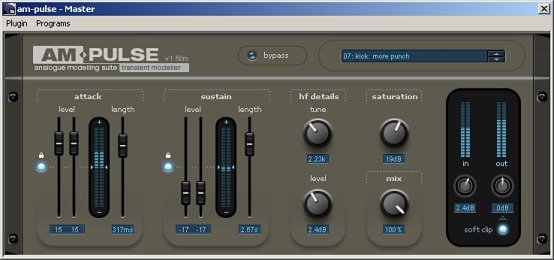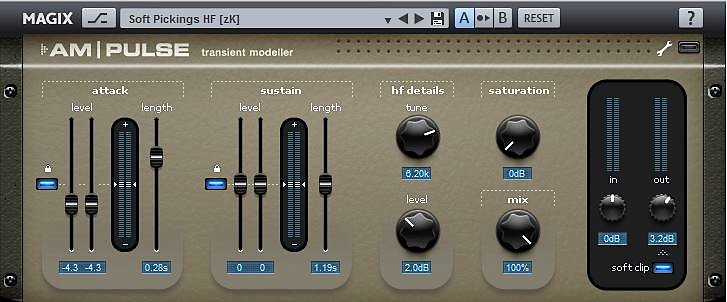AM-Pulse is often mentioned as a great tool for mixing purposes. This is a partial truth, and it's about this great (and forgotten) plugin that I would like to write now.
My claI'm in this topic is just to touch on some interest - or curiosity - for the use of this tool that on many occasions has surprised me in a very positive way. The following writing is a consolidation of several articles on how this plugin is useful, not only for mixing purposes, but also for mastering.
TRANSIENT SHAPING
A transient is a high amplitude, short-duration sound at the beginning of a waveform. It is the initial hit of a sound - initial attack. It's what you first hear when an instrument is made to product a sound or when a beater is applied to a kick drum, that initial thud. Everything that happens after that is how the sound decays, and the transient refers to what happens when a sound is first produced. You can use a transient to make it hit faster or slower. It helps the sound harmonize with the entire track. The main sound is left unaffected.
Transient Shaping (Transient Shapers, Transient Designers, Envelopers) is the art of altering the sudden peaks of a piece of audio. It intends to emphasize the transient response of a recording, that is, to exaggerate the initial sound of a stick on a snare and leave alone the decay event.
These plugins act as equalizers and compressors and they are generally used for percussion instruments like drums. When the effect is increased the plugins make the drum’s tone sharp and very clear throughout the different layers of audio present in the file; decreased, the drum sound is mellowed.
They stand somewhere between equalizers and compressors, but the aI'm of Transient Shaping is to affect only the Attack and Sustain phase of a sound, so these effects are capable of enhancing or attenuating each of these with precise accuracy.
It’s very easy to get perfect balance of the bass with perfectly locking in the drum track with it, making the sound complete and crunchy. It helps in equalizing the track and keeps everything in balance.
COMMON CONTROLS
- Attack: Increase the punch of the initial part of the sound, or lower it to make it softer and less "in your face". This function adds or subtracts decibels like an equalizer, boosting or cutting the amplitude of the first part of the sound.
- Sustain: This control affects the "tail" of the sound. The sustain control is useful to get the sound closer or farther away from the listener, leaving it more natural.
- Gain: It is used to lower the volume of the sound when needed, especially when increasing the attack: the volume of the signal will be increased, so it’s well worth lowering the output level of the plugin to avoid clipping.
ADDING PUNCH
Make the sound louder, give it more expressiveness and more punch by increasing the attack. Life is added and you can clearly hear the punch introduced to the initial transients.
When adding attack in this way the volume of the signal will be increased, so it’s well worth lowering the output level of the plugin to avoid clipping.
SOFTENING A SOUND’S ATTACK
The exact opposite of adding punch and snap to sounds involves softening the attack of a sound’s transients. For instance, say you record a percussion or guitar part and you find the microphones were too close. You may find these sharper sounds have a little too much bite and cut into other elements of your mix.
Traditionally, the solution would be to use dynamics processors such as a compressor or limiter and in some cases the situation might even require going back to the drawing board and re-recording the sound! This is where transient design really comes into its own as a problem solver, it really can save the day when it comes to getting certain instruments to sit perfectly in the mix.
Do a reduction of the attack phase. The sound aggressive nature is now tamed and would now sit comfortably in a mix with other punchy elements.
SUSTAIN EFFECTS
Working on the sustain helps in making the entire track sound more natural without loose ends.
By dialling in large amounts of sustain, really interesting effects can be produced. Often the result can be comparable to that of driving a compressor really hard. This is certainly more of an effect that a problem solving technique but it can be great for increasing the apparent volume of sounds and imparting some character.
REMOVING ROOM SOUND AND EFFECTS
Another really useful technique using transient processing is removing room sounds from a recording, or even excessive reverb or delay that may have been imprinted on a file. To do this its simply a case of reducing the sustain control to the right amount. Take things too far and you can end up with nothing more than a snap from the attack phase of the sound.
AM-PULSE
AM-Pulse is arguably the most musical transient shaper available in software. The parallel processing may be a key factor in this, as it seems to make it possible to change the dynamics of an incoming signal without ending up in that situation where the note attacks sound 'stuck on' to the rest of the track. The enhancer is a nice addition, and can work with the transient-shaping algorithm to help pick out a certain part of the sound In a surprisingly natural way.
Magix's algorithm is capable of detecting two separate phases in the dynamic of an incoming sound:
- The initial transient, or Attack
- The subsequent Sustain phase
You can specify the duration and amount of any boost or cut that is applied when a transient or sustain phase is detected.
Following the transient shaping, the signal passes to an Enhancer and a Saturation effect and there's a Mix control allowing you to set up parallel processing.
If there's a down side to this, it's that it is not simply set-and-forget processor, and you should expect to spend a little while learning what all the controls do before you can get the best from it.
AM-Pulse was made by Sasha Eversmeier (the same of AM-Munition and so on) and in its early days, this plugin was called "dominion" and it was born as a free plugin - still available for download http://www.digitalf…"]here[/]="http://www.digitalf…"]here[/].
Take a look in its visual progress, then and now:
MASTERING TOOL
Transient Designers - AM-Pulse here - also tend to be very versatile and are not just limited to drums as is often the misconception. They can even work wonders as part of a mastering chain.
In poor mastering where the drum tracks were hidden or muffled, the AM-Pulse can - remarkably - bring forward the beats that make a big difference in a "weak" music. seeming even a new song, much more clear and enjoyable to be heard (if its parameters are properly calibrated, of course).
There’s not a huge amount ‘to’ transient shaping, but if you’ve ever used a huge chain of compressors, gates, manual amplification adjustments and so on to get the thump of a kick to become more pronounced or the picking of a guitar to be softer, then you’ll appreciate how AM-Pulse can save you a huge amount of time for the same result!
After trying it out, you may not be able to live without it anymore.






It's a great tool. I used it for shaping the the piano track on
It's a great tool. I used it for shaping the the piano track on [[url=http://[/URL]="http://recording.or…"]this song.[/]="http://recording.or…"]this song.[/]
I also used Ammunition on the 2-bus, and Am-Track on some other tracks in the same song. I love Samp's modeling. :)